Belkin F9K1117V2 AC1200 DB Wi-Fi Dual-Band AC+ Gigabit Router User Manual Regulatory Information
Belkin International, Inc. AC1200 DB Wi-Fi Dual-Band AC+ Gigabit Router Regulatory Information
Belkin >
Contents
- 1. User manual
- 2. user manual
- 3. User Manual
User Manual
<NEW BELKIN LOGO><Please use colors of AC1200 (F9K1113)>
Wireless AC+ Gigabit ROUTER
AC1200 DB
USER MANUAL
8820-01755 Rev. A01
F9K1113V4
TABLE OF CONTENT
Getting Started123
What’s in the Box
Initial Setup
Manually Set Up Your Internet Connection
Additional Capabilities
Adding Other USB Devices
USB Print and Storage Manager
Guest Access
Media Server by myTwonky
Content Filtering by Norton
Intellistream QoS
IPv6 Configuration
Getting to Know Your Router
Front Panel
Back Panel
Technical Details
Technical Features
System Requirements
Using Your Router
Enabling Auto Update on Your Router
Updating the Router’s Firmware via the Web Interface
Resetting the Router
Restoring your Router to Factory Default
Troubleshooting, Support, and Warranty
Troubleshooting
Technical Support
Belkin International, Inc., Limited 2-Year Product Warranty
Regulatory Information
FCC Statement
Getting Started
What’s in the Box
AC1200 DB Wireless AC+ Gigabit Router
Ethernetcable(attachedtorouter)
Powersupply(attachedtorouter)
Networkinformationcard(attachedtorouter)
Quick Setup Guide
Initial Setup
WheretoPlaceYourRouter
Forthebestresults,placetheRouternexttoyourmodeminan
openlocation,awayfromlargemetalobjectsandmagnetssuchas
thosefoundinspeakers.RaisingtheRouterabovefloorlevelcan
improvethestrengthofyourwirelesssignal.
HowtoSetItUp
Connect Your AC1200 DB Router
΅ΦΣΟ͑ΠΗΗ͑ΪΠΦΣ͑ΞΠΕΖΞ͑ΓΪ͑ΕΚΤΔΠΟΟΖΔΥΚΟΘ͑ΚΥΤ͑ΡΠΨΖΣ͑ΤΦΡΡΝΪ͑͟΄ΠΞΖ͑ΞΠΕΖΞΤ͑ΙΒΧΖ͑Β͑ΓΒΥΥΖΣΪ͑
ΓΒΔΜΦΡͬ͑ΥΙΚΤ͑ΨΚΝΝ͑ΟΖΖΕ͑ΥΠ͑ΓΖ͑ΕΚΤΔΠΟΟΖΔΥΖΕ͑ΒΥ͑ΥΙΚΤ͑ΥΚΞΖ͑ΒΤ͑ΨΖΝΝ͑͟
ͭΡΝΖΒΤΖ͑ΦΤΖ͑ΚΞΒΘΖ͑͑͢ΗΣΠΞ͑ΤΥΖΡ͑͑͢ΠΗ͑ΥΙΖ͑ΟΖΨ͑ΨΖΝΔΠΞΖ͑ΔΒΣΕ͑Ρ͔͑ͩͩͣͣͣ͑͢͡͞͡͡ΖΧ͑Ͳͯ͑͡͡
͑
ʹΠΟΟΖΔΥ͑ΪΠΦΣ͑ΠΦΥΖΣ͑ΥΠ͑ΪΠΦΣ͑ΞΠΕΖΞ͑ΦΤΚΟΘ͑ΥΙΖ͑ΔΒΓΝΖ͙͑ΒΝΣΖΒΕΪ͑ΒΥΥΒΔΙΖΕ͚͑͟
͑
͑
ͭΡΝΖΒΤΖ͑ΦΤΖ͑ΚΞΒΘΖ͑ͣ͑ΗΣΠΞ͑ΤΥΖΡ͑͑͢ΠΗ͑ΥΙΖ͑ΟΖΨ͑ΨΖΝΔΠΞΖ͑ΔΒΣΕ͑Ρ͔͑ͩͩͣͣͣ͑͢͡͞͡͡ΖΧ͑Ͳͯ͑͡͡
͑
͑
ΠΨΖΣ͑ΦΡ͑ΪΠΦΣ͑ΞΠΕΖΞ͑ΓΪ͑ΡΝΦΘΘΚΟΘ͑ΚΟ͑ΚΥΤ͑ΡΠΨΖΣ͑ΤΦΡΡΝΪ͑͟ͺΗ͑ΪΠΦΣ͑ΞΠΕΖΞ͑ΙΒΤ͑Β͑ΓΒΥΥΖΣΪ͑ΓΒΔΜΦΡ͑͝
ΚΥ͑ΔΒΟ͑ΓΖ͑ΣΖΔΠΟΟΖΔΥΖΕ͑ΒΥ͑ΥΙΚΤ͑ΥΚΞΖͬ͑ΪΠΦ͑ΞΒΪ͑ΟΖΖΕ͑ΥΠ͑ΙΠΝΕ͑ΥΙΖ͑ΣΖΤΖΥ͑ΓΦΥΥΠΟ͑ΗΠΣ͑͑͢͡ΤΖΔΠΟΕΤ͑͟
͑
ΠΨΖΣ͑ΦΡ͑ΪΠΦΣ͑ΠΦΥΖΣ͑ΓΪ͑ΡΝΦΘΘΚΟΘ͑ΚΟ͑ΚΥΤ͑ΡΠΨΖΣ͑ΤΦΡΡΝΪ͑͟
͑
ͭΡΝΖΒΤΖ͑ΦΤΖ͑ΚΞΒΘΖ͑ͤ͑ΗΣΠΞ͑ΤΥΖΡ͑͑͢ΠΗ͑ΥΙΖ͑ΟΖΨ͑ΨΖΝΔΠΞΖ͑ΔΒΣΕ͑Ρ͔͑ͩͩͣͣͣ͑͢͡͞͡͡ΖΧ͑Ͳͯ͑͡͡
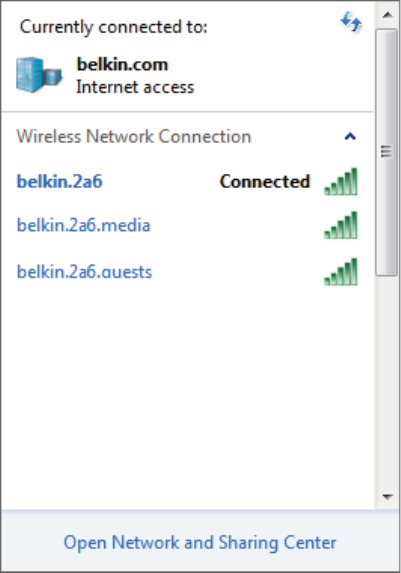
Connect to Your Router
Retrieve the network ID card from the foot of your new Belkin
Router.
[Diagram of bottom of the router showing service card – can be
obtained from “Tested QIG 2011 07 14.pdf” provided]
Can’t find the card? The default network name and password are also printed on the foot of
the Router.
Use your computer, tablet, or smartphone to connect to the
wireless network shown on the network ID card.
For information on how to connect your wireless devices, please see the “Connect Your
Wireless Devices” section on page 20.
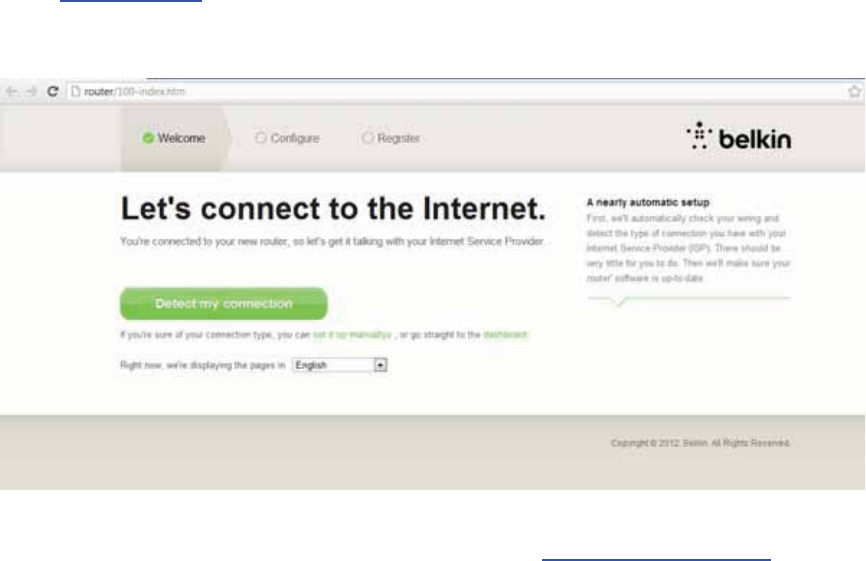
When requested, please enter the password (security key) provided
on the card.
WhenyourdevicehasconnectedtotheRouter,useabrowserto
visithttp://router/.Therouter homepage willappear.
If the page does not load, then try visiting http://192.168.2.1 to see
the router homepage.
Click the “Detect my connection” button in green. (If you would
rather set up the Router manually, click the “set it up manually”
link and proceed to page 10.)
After several moments, your Router should automatically detect
your Internet connection and restart. This can take anywhere from
30 seconds to 3 minutes depending on your connection type.
If your Router is unable to establish an Internet connection on its
own, you may be asked to restart your modem or provide a
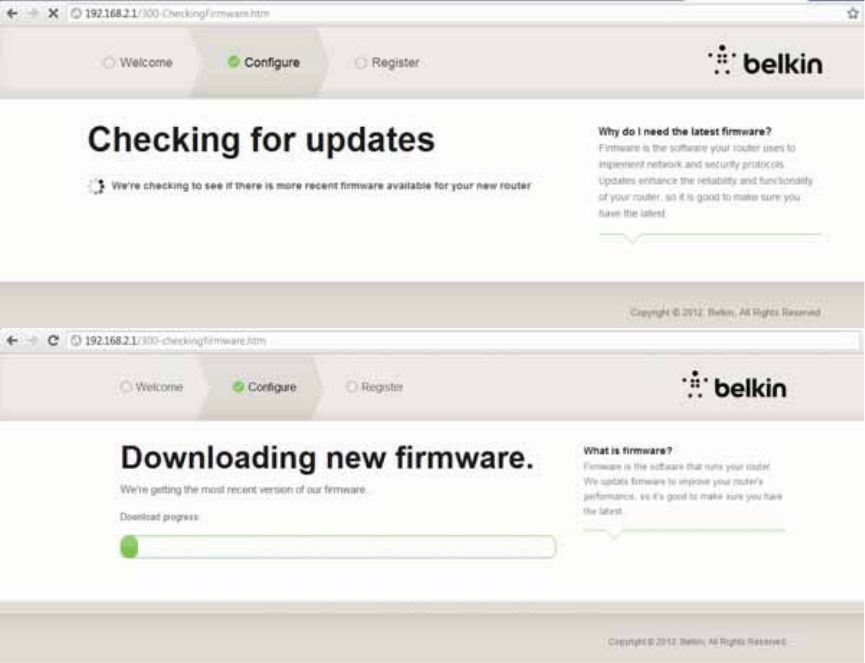
username and password if your connection requires one. Follow
the on-screen instructions provided.
Once your Router is online, it will determine if there is a firmware
update available and offer to install it. Please allow up to 5 minutes
for the firmware to update.
If there are no updates available, then setup will proceed.
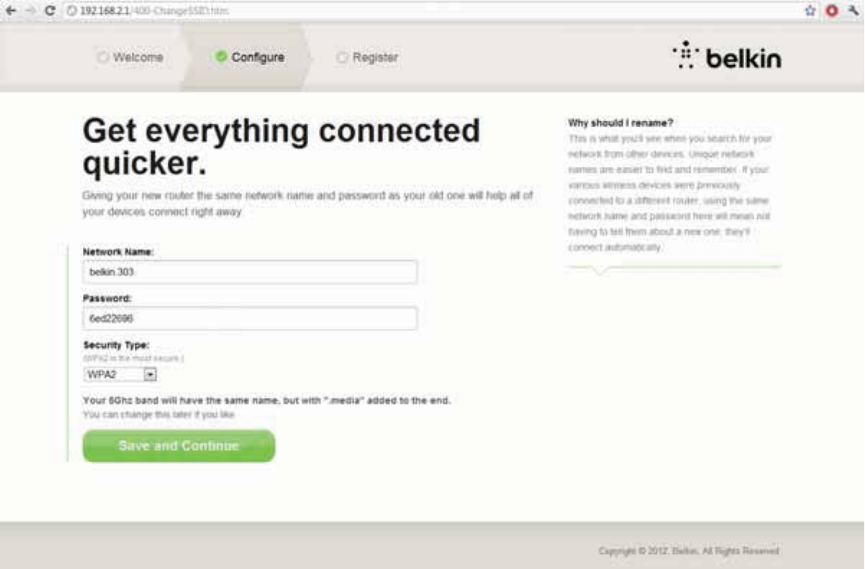
At the next screen you will be invited to change your network
name and password. Re-using your previous network name (SSID)
and password makes connecting your existing devices to the new
router much easier.
If you decide to change these settings, then enter the new values
and click “Save and Continue.” (Note: The password must be at
least 8 characters long.)
If you changed your network name and password, make note of it
on the service card located on the foot of the Router. You will then
have to connect to the new network.
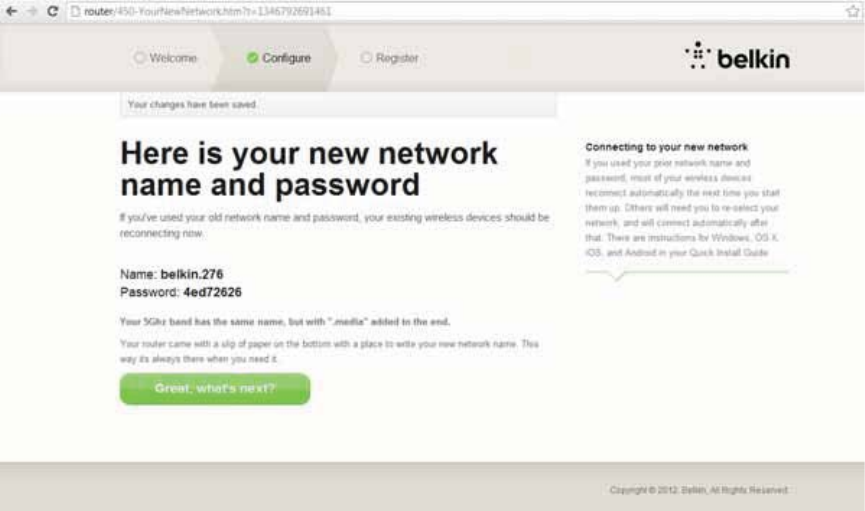
Please take this opportunity to register your Router. This will help
technical support if there is a problem with your Router.
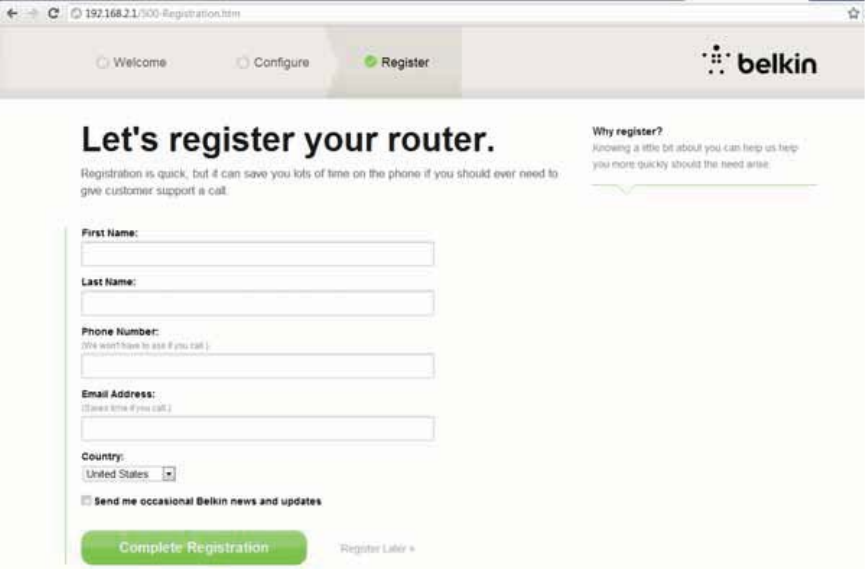
Simply complete each of the required fields and click “Complete
Registration.” If you don’t want to register right now, click
“Register Later” to proceed.
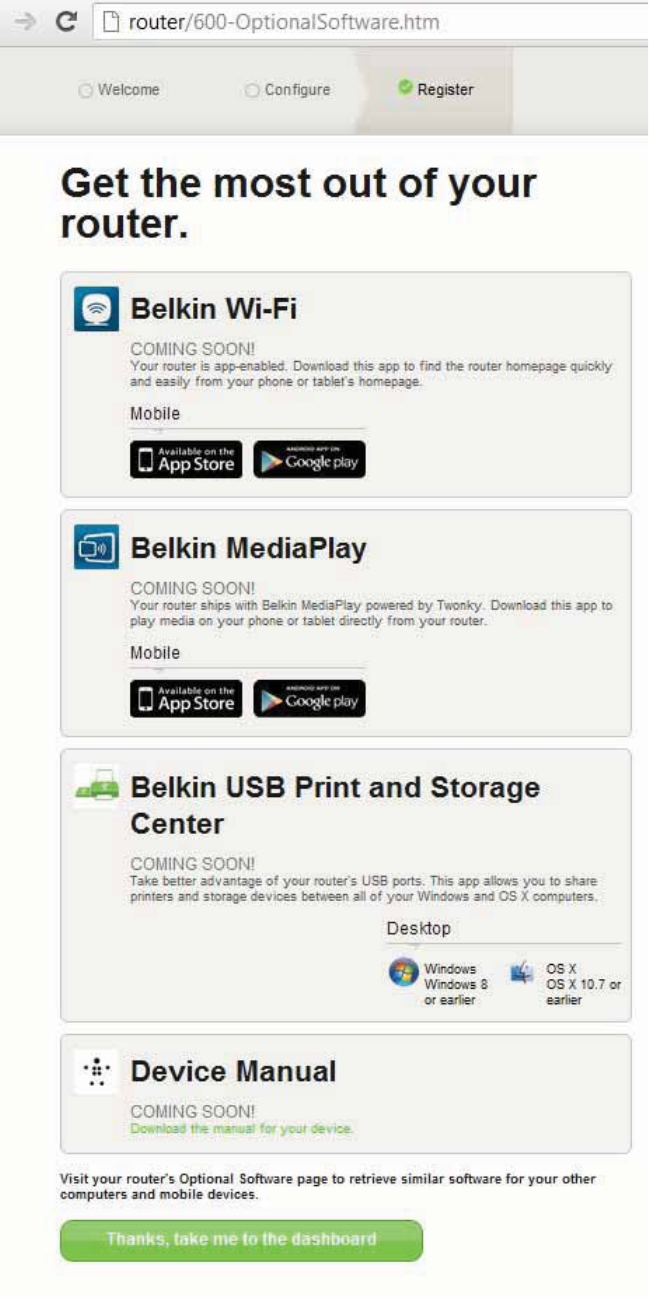
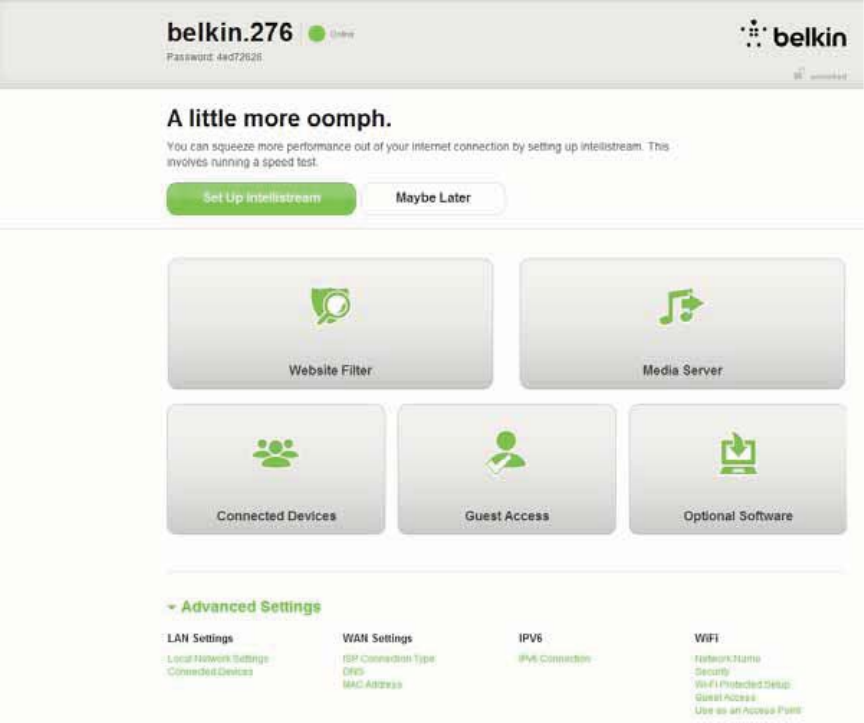
At the next screen you can download optional software that was
bundled with your Router.
This screen shows you optional software that is available for your
Router, such as the USB software to allow you to print through the
Router’s USB port. If you wish to download and install any of
these software programs, simply click on the button appropriate for
your device.
When finished installing optional software, click “Thanks, take me
to the dashboard.”
Congratulations! You are now at your Router’s dashboard. Your
Router is set up and ready to use.
UsingtheWPSButton
1)StartWPSPushButtonConnection(WPSPBC)onyour
computerorotherWiFidevicethatyouwouldliketo
connectwirelesslytoyourRouter.Oftentherewillbea
buttonforthispurposeinsoftwarethatcamewiththedevice,
oraphysical“WPS,”“PBC,”or“Security”buttononthedevice
itself.
2)Withintwominutes,presstheWPSbuttononyourRouter
andholdfortwoseconds.
TheWPSlight(smalllightaboveWPSbutton)willblinkblue
whileitlistensforyourWiFidevice.Onceaconnectionis
established,thelightwillturnblueandthengoout.Ifa
connectionisnotestablished,thelightwillblinkamber.You
mayrepeattheprocesstotryagain.
YoucanrepeatthisprocessforeachWPSenableddeviceyou’d
liketoaddtoyournetwork.
Manually Set Up Your Internet
Connection
Use a browser to visit http://router/. You can also try visiting http://192.168.2.1/. The
Router’s Welcome page should appear.
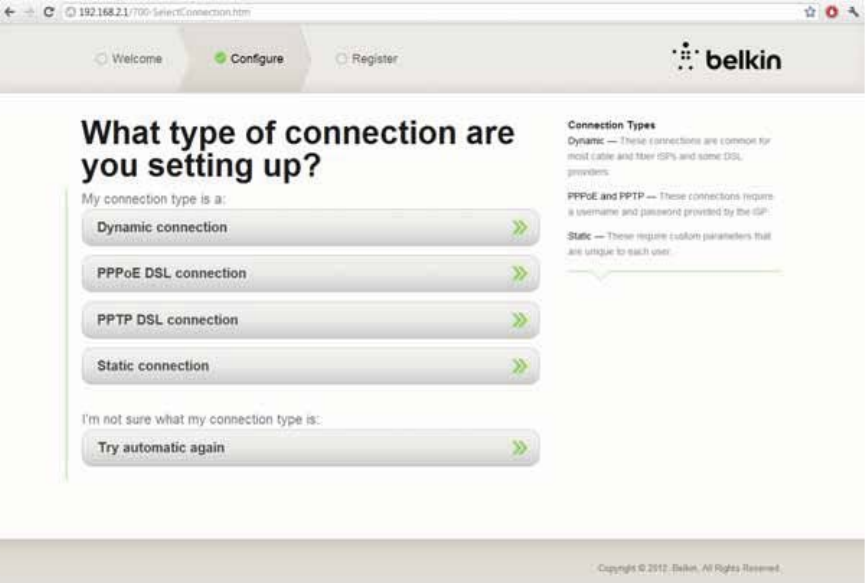
Click the “Set it up manually” link. Please select the type of connection your ISP
provides. Refer to page 15 for a description of the connection types.
<Image of SelectConnection screen>
If the selected connection type requires additional information
(such as an ISP username and password), the system will ask you
for it.
At the next screen you will be invited to change your network
name and password. Reusing your previous network name (SSID)
and password makes connecting your existing devices to the new
router much easier.
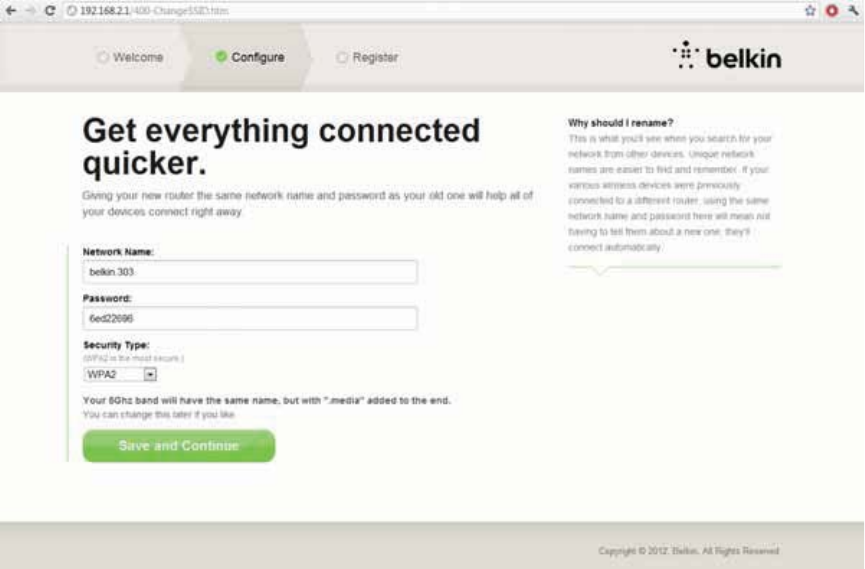
If you decide to change these settings, then enter the new values
and click “Save and Continue.” (Note: The password must be at
least 8 characters long.)
If you changed your network name and password, make note of it
on the service card located on the foot of the Router. You will then
have to connect to the new network. Please refer to page 20 to do
this.
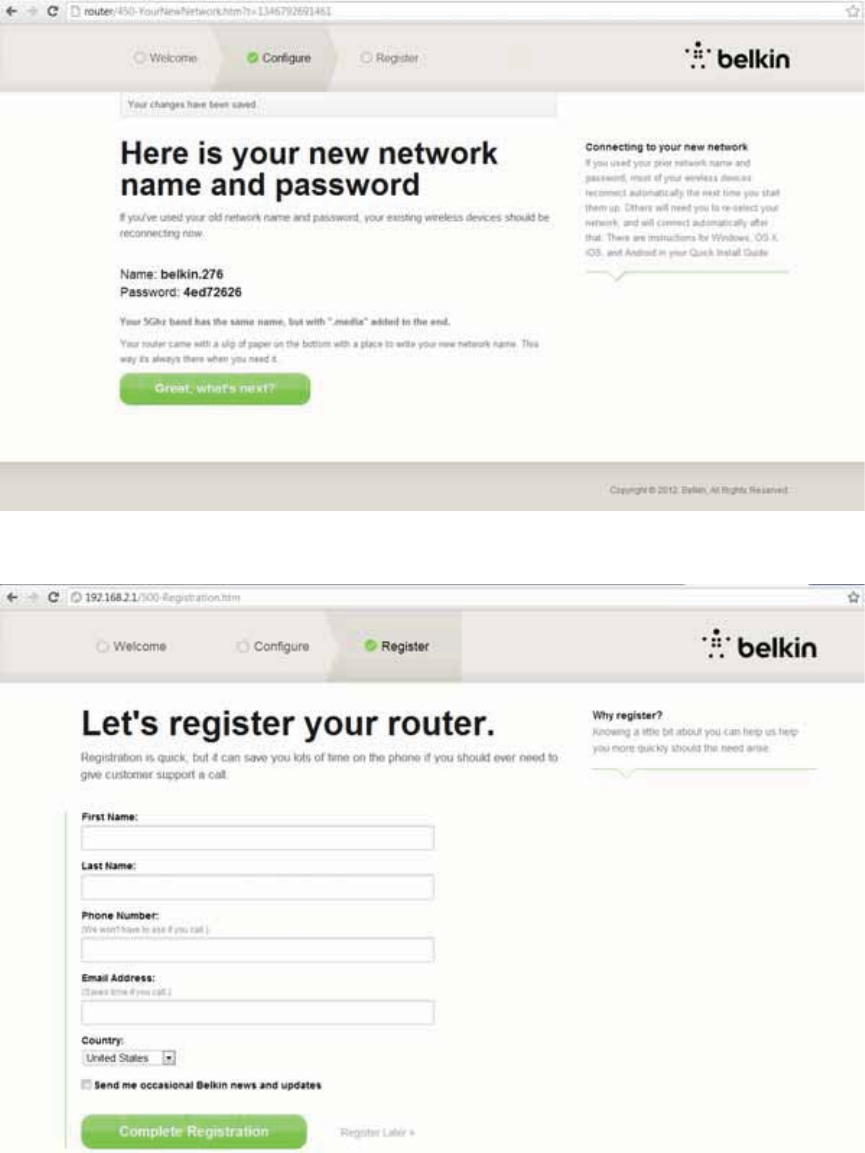
Click “Great, what’s next?”
Please take this opportunity to register your Router. This will help
technical support if there is a problem with your Router.
Simply complete each of the required fields and click “Complete
Registration.” If you don’t want to register right now, click
“Register Later” to proceed.
At the next screen you can download optional software that was
bundled with your Router.
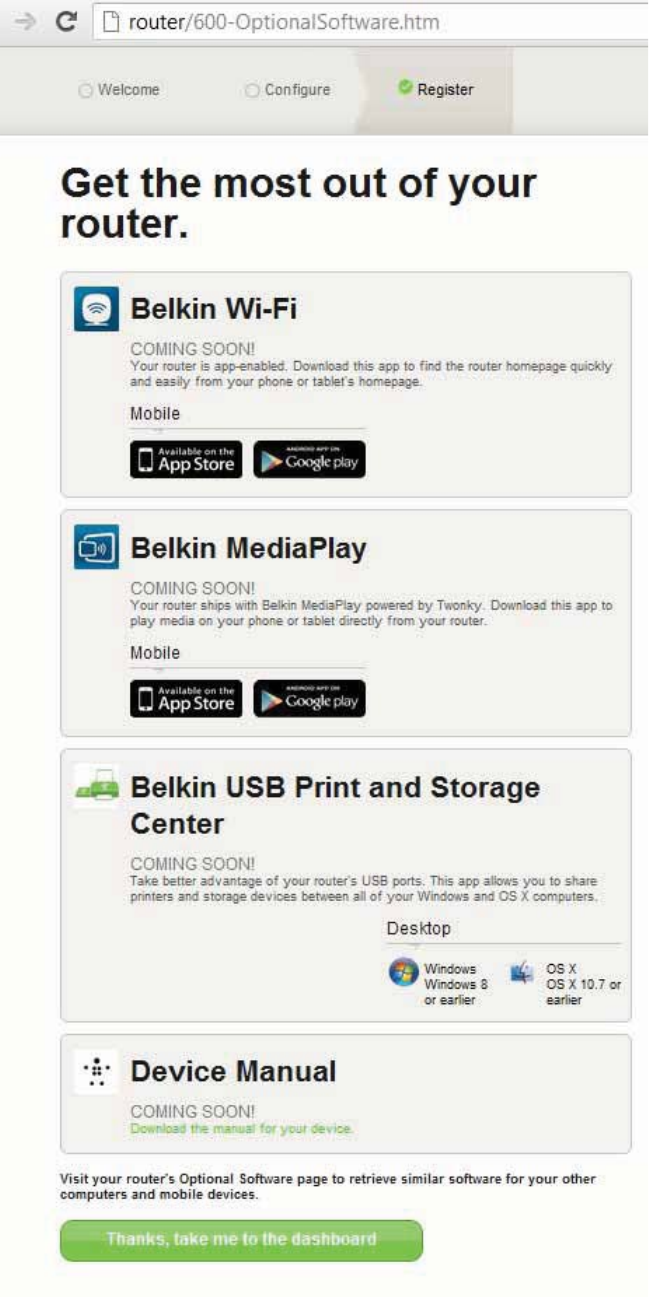
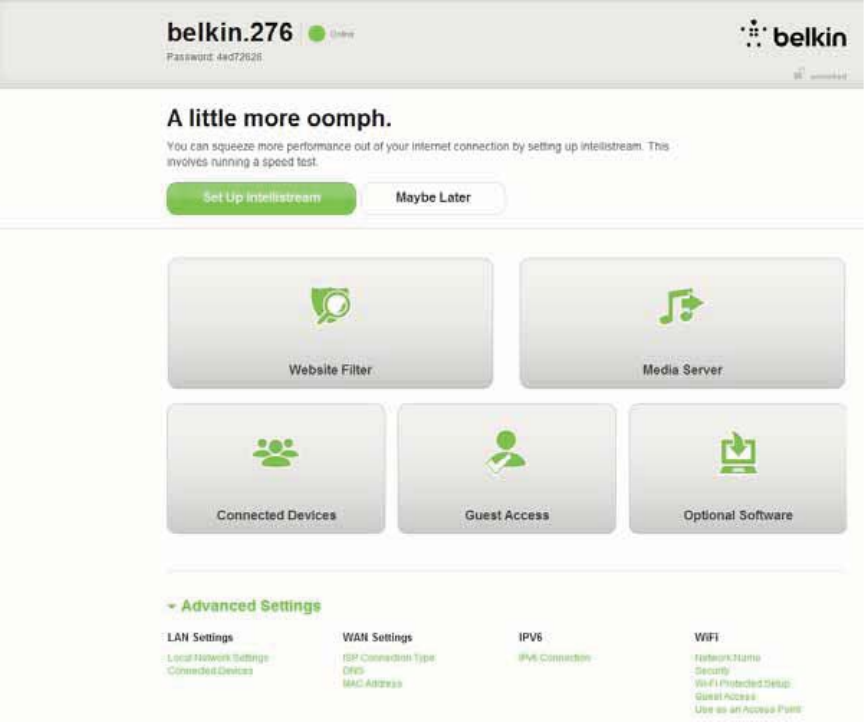
This screen shows you optional software that is available for your
Router, such as the USB software to allow you to print through the
Router’s USB port. If you wish to download and install any of
these software programs, simply click on the button appropriate for
your device.
When finished installing optional software, click “Thanks, take me
to the dashboard.”
Congratulations! You are now at your Router’s dashboard. Your
Router is now set up and ready to use.
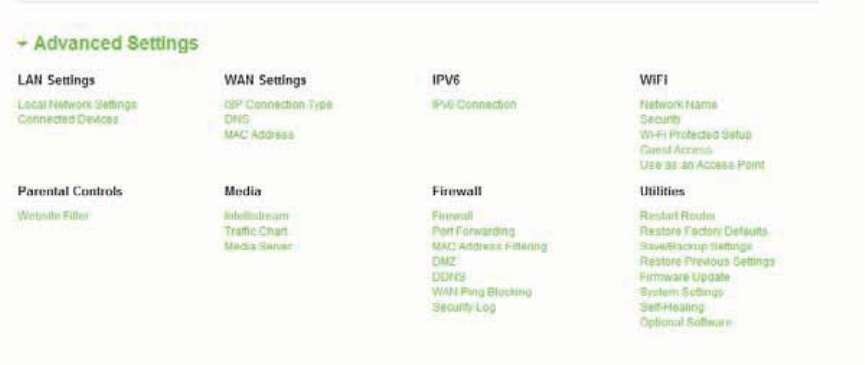
ThestatusofyourInternetconnectionisshownintheupperleft
corneroftheRouter’shomepage.
If it does not say “Online,” troubleshooting information will be
displayed.
Manually Configuring Your Router’s
Internet from the Dashboard
To set up your ISP connection manually, select “ISP Connection
Type” from the list under the header “WAN Settings.”
Dynamic Connection
Cable and fiber customers generally require a dynamic
connection. Some DSL customers require a PPPoE
connection. Let’s try dynamic first. Select “Dynamic” from the
menu that appears and press “Next.”
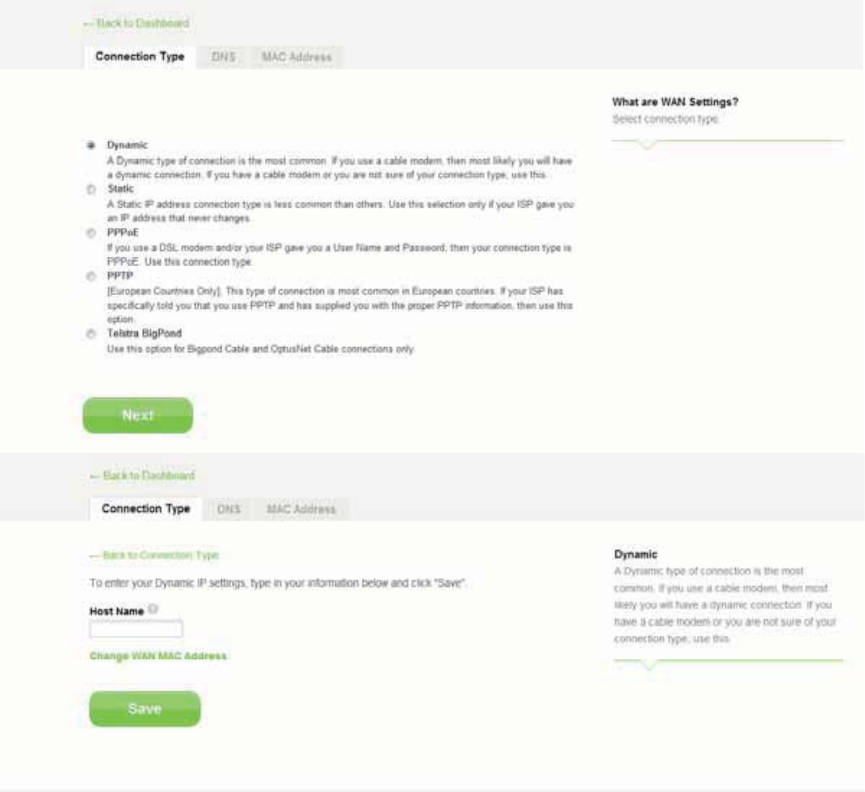
A host name is generally not required. Hit “Save.” The Router will
restart.
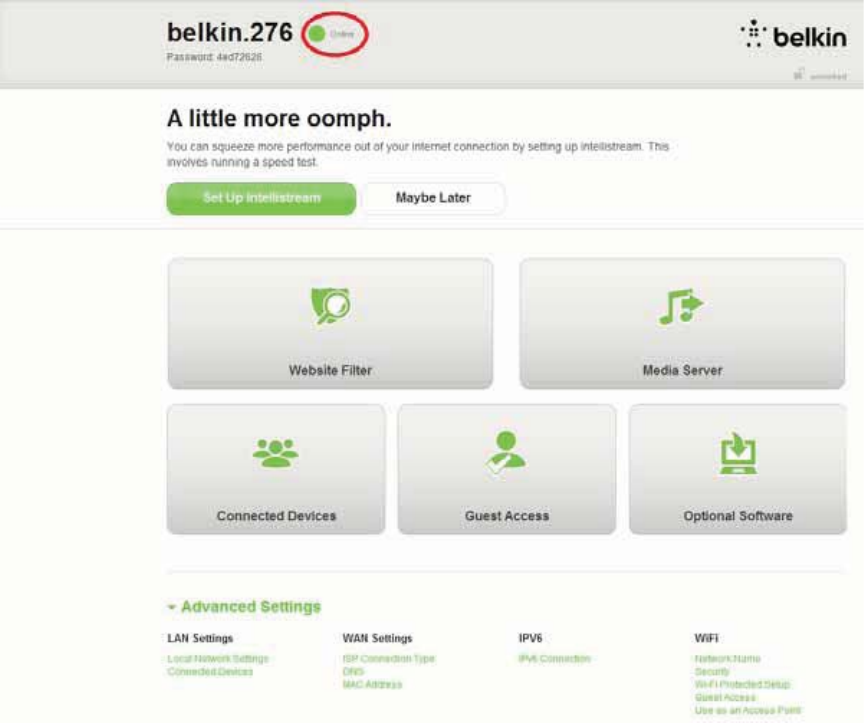
If after a few minutes your Internet Status says “Online,” you’re
done! You can surf the Internet.
If these steps do not work, try restarting your modem and
repeating the process.
If not, we’ll try a PPPoE connection next.
PPPoEConnection
SomeDSLcustomersrequireaPPPoEconnection.SelectPPPoE
thistimeandpress“Next.”
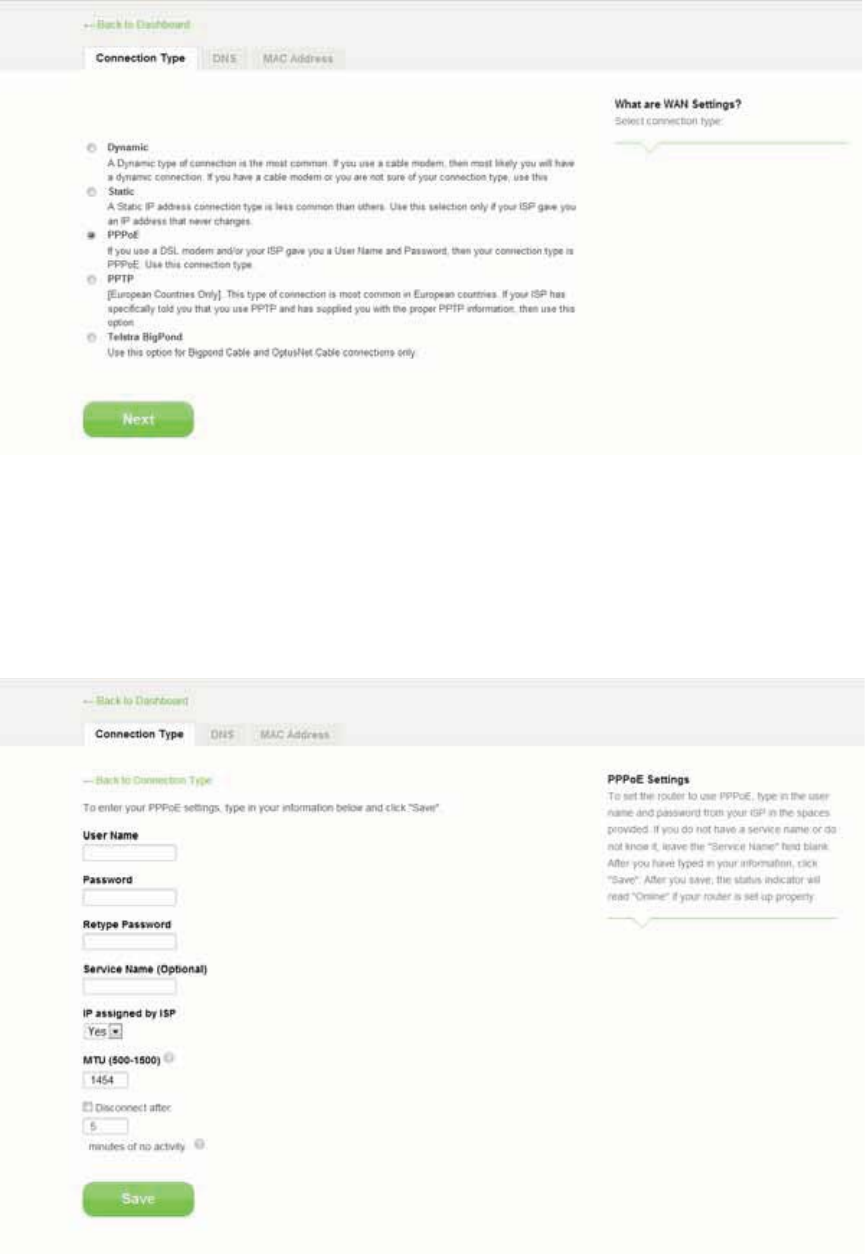
Enter the username and password supplied by your Internet
provider and click “Save.” Ignore the other fields unless required
by your ISP. The Router will restart.
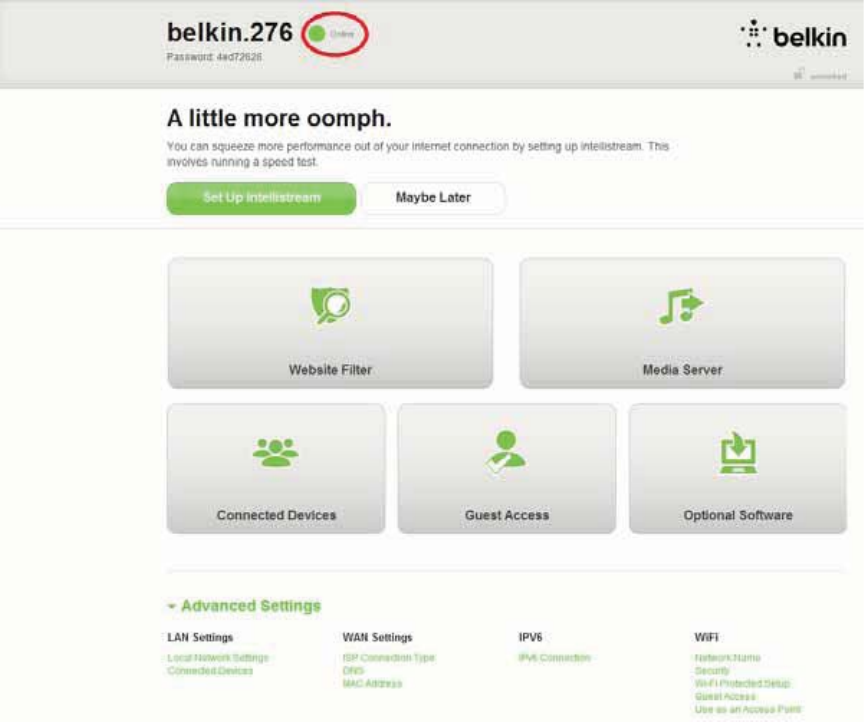
If after a few minutes your Internet Status says “Connected,”
you’re done! You can surf the Internet.
If these steps do not work, try restarting your modem and
repeating the process.
Connect Your Wireless Devices
iOS <Add iOS icon from welcome card>
(iPhone, iPad, and iPod touch)
1. Open the Settings app and select the Wi-Fi menu item.
2. Select your wireless network from the list that appears there. If
asked to do so, enter the network password.
Mac OS® X <add Mac icon from welcome card>
Your Mac® provides a menu of available wireless networks at the right
end of the menu bar.
1. Click on the icon showing wireless waves.
2. Select your wireless network from the list that appears there. If
asked to do so, enter the network password.
Android™ <add android icon from welcome card>
(phones and tablets)
1. Open the Settings app and select Wireless and Network.
2. From there, select Wi-Fi to see the list of available networks.
3. Select your wireless network from the list. If asked to do so, enter
your network password
Windows® 7 <add win7 icon from welcome card>
Your computer provides a menu of available wireless networks at the
right end of the task bar.
1. Left-click on the icon that looks like signal strength bars.
2. Select your wireless network from the list. If asked, enter your
network password (network key).
Windows Vista® and Windows XP
Your device provides a menu of available wireless networks at the
right end of the task bar.
1. Right-click on the icon that shows a computer with wireless
waves (XP) or two computers (Windows Vista).
2. Choose “View Available Wireless Networks (XP)” or “Connect to a
network (Vista)” from the menu.
3. Select your wireless network from the list. If asked, enter your
network password (network key).
͑
Additional Capabilities
Adding USB Devices
[USBINVITATIONDIAGRAM(TBD)]
AddingaDrive
YoucanshareaUSBharddriveorflashdrivetoyournetworkvia
yourRouter’sUSBport.Onceconnected,youcansharefilesand
musicwithothercomputersanddeviceswithinyournetwork.
PlugyourUSBharddriveintotheUSBportonthebackofyour
Router.
Youcanmanuallycheckthestatusofyourshareddriveby
visitingtheUSBPrintandStorageManager.Ifyouhave
difficultysharingadriveonyournetwork,pleaseseethe
“Troubleshooting”sectionofthismanual.
A few USB hard disks require more power than the Router’s USB port provides. In these
cases, you may notice the drive failing to come on or remaining on for a short time. If
your disk has an optional power supply, please use it while the disk is attached to your
Router.
AddingaPrinter
YoucanaddaprintertoyournetworkviayourRouter’sUSBport.
Onceconnected,youcanprintfromvariouscomputersand
wirelessdeviceswithinyournetwork.
Plugyourprinter’sUSBcableintotheUSBportlocatedontheback
ofyourRouter.
Youcanmanuallycheckthestatusofyourprinterbyvisitingthe
USBPrintandStorageManager,foundundertheBelkinicon
displayedinyoursystemtray(Windows)ormenubar(Mac).Ifyou
havedifficultysharingaprinteronyournetwork,pleaseseethe
“Troubleshooting”sectionofthismanual.
Note:Eachcomputerthatwillusetheprintermusthaveboththe
Belkinsoftwareandtheprinter’sdriverinstalled.Iftheprint

driverisnotinstalled,youwillbeaskedtoinstallitbytheBelkin
USBPrintandStorageManager.
AddingOtherUSBDevices
OtherUSBdevicesmayalsobesharedviayourRouter.Plugyour
deviceintotheUSBportlocatedonthebackofyourRouter.
ComputersrunningtheBelkinUSBPrintandStorageManagerwill
beabletomakeuseoftheshareddevice.
Optional Software
USBPrintandStorageCenter
TheUSBPrintandStorageCenterhelpstomanageandmonitorthe
useofyourUSBprinters,scanners,harddrives,andotherdevices
thatareconnectedtoyourRouter’sUSBportandsharedacross
yournetwork.
Additional Capabilities
GuestAccess
YoucanallowgueststouseyourInternetconnectionwithout
joiningyourpersonalnetwork.Thenetworknameandpassword
fortheguestnetworkislocatedonthenetworkinformationcard
foundunderthefootofyourRouter.
Apersonusingyourguestnetworkwillbeabletojoinwithouta
password,butwillbeshownaloginpagewhentheyattempttosurf
theWeb.Theywillneedtoentertheguestpasswordintothispage
tocontinue.
Media Server by myTwonky
Media Server by myTwonky lets your Router stream music, movies, and photos
to different DLNA/UPnP devices on your network.
In order to use Media Server by myTwonky, you will need to insert a USB
storage device with media content into a free USB port on the back of your
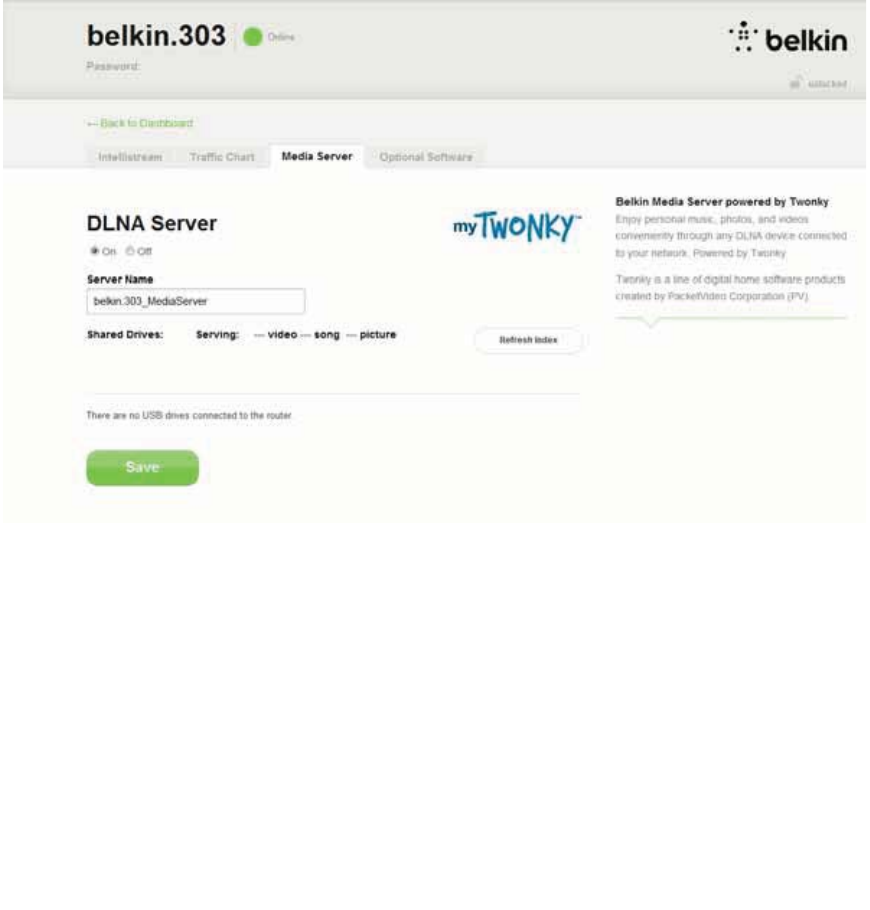
Router. Your Router will begin to make your content available to other devices on
your network automatically.
If you want to configure Media Server by myTwonky, visit http://router/ and
choose “Media Server.”
There are several settings in the configuration page:
DLNA Server: Enables or disables your media server
Server Name: The name under which other devices will see your content
Refresh: Re-scans your USB storage devices for media content
Shared Drives: Shows information about and status of each of your attached
drives. You can see the name of the drive, its capacity, and whether media is
being served from it or not.
When you click “Save,” your Router will save your changes.
Website Filters. Powered by Norton
Web filters provide a first layer of whole-home Internet protection to guard you
from unsafe and inappropriate websites on any device on your network.
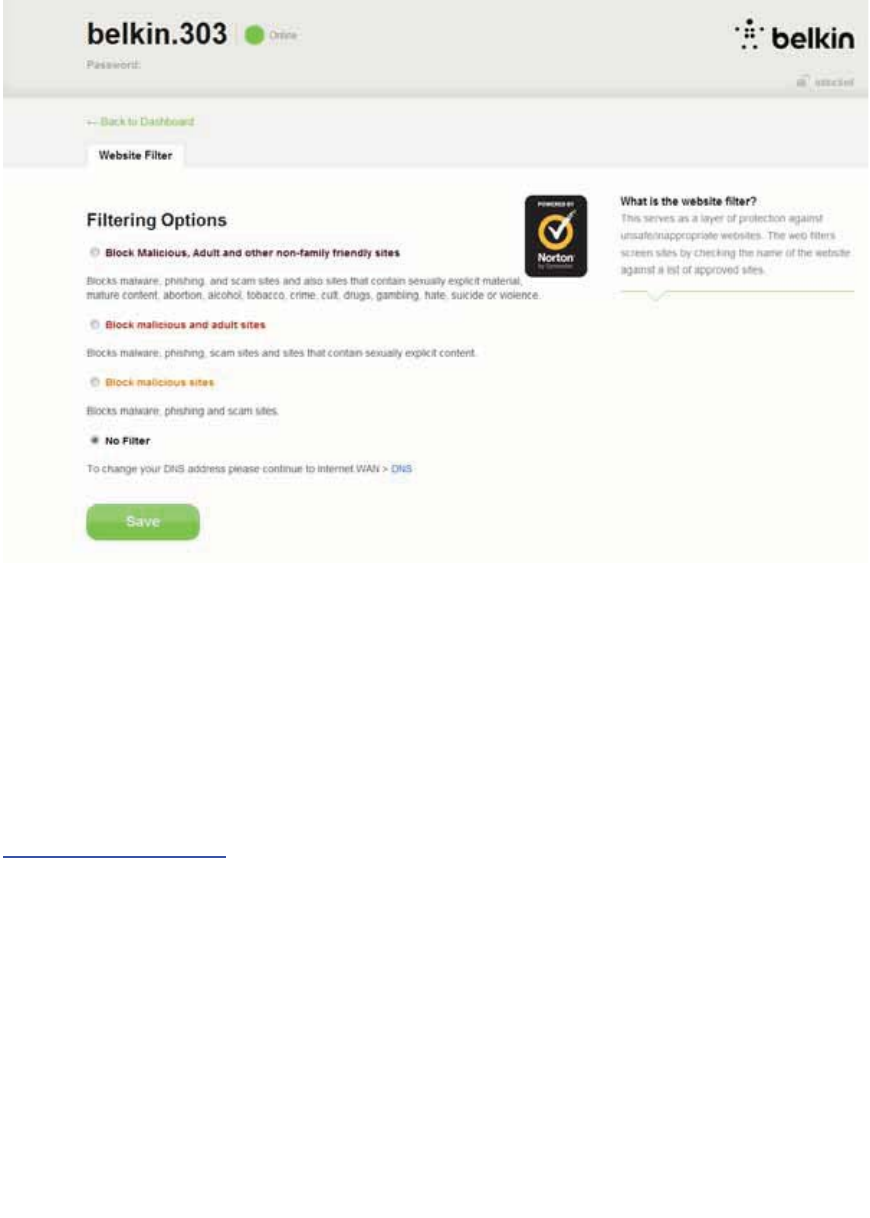
There are four different filtering options:
1. Block malicious, adult, and other non-family-friendly sites
2. Block malicious and adult sites
3. Block malicious sites
4. No filters
If you think a site should be added to the filtering list, submit a request at
safeweb.norton.com.
Content filtering may not work as intended if:
1. You are connecting through a VPN router.
2. You are routing traffic through a proxy server.
3. You have previously visited the site and it has been stored in your cache.
4. You manually set the DNS servers on your computer, tablet, or
smartphone.
Intellistream QoS
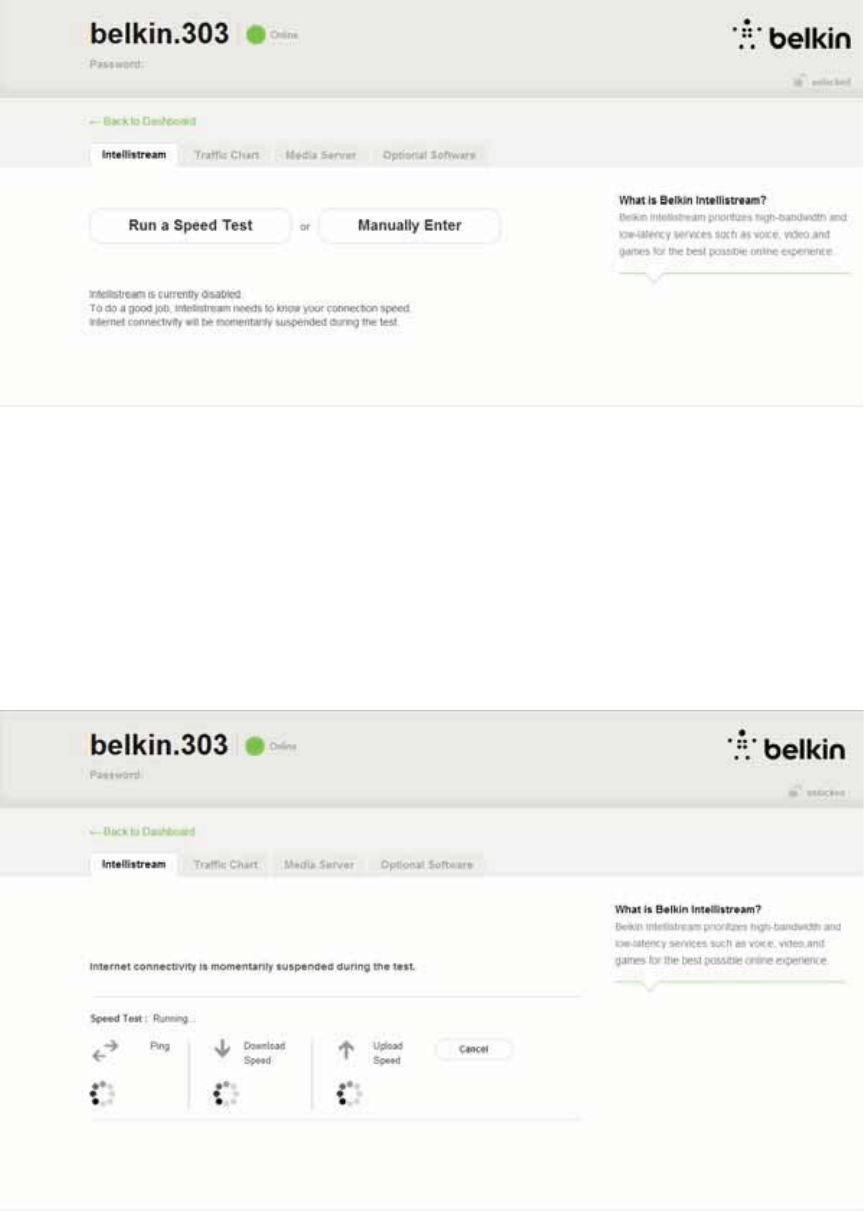
Intellistream prioritizes video and gaming traffic for a better online entertainment
experience.
There are two ways to enable Intellistream:
Run a Speed Test:
In order for Intellistream to provide you the best media experience, your Router
needs to know what your approximate Internet speeds are.
Click “Run a Speed Test” and the test will begin.
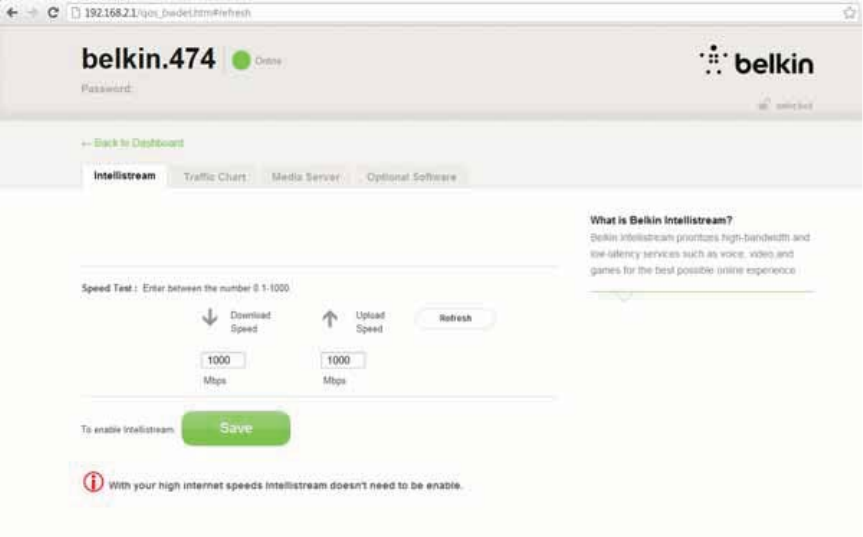
Once complete you will see the results.
If your Internet speed is greater than 70Mbps when downloading, Intellistream
QoS will only improve your uploading experience.
Refresh – This will retest your Internet speed.
When you click “Save,” your Router will save your changes.
Manual set – This will let you set your approximate Internet speeds. If you do not
know your Internet speeds, contact your ISP.
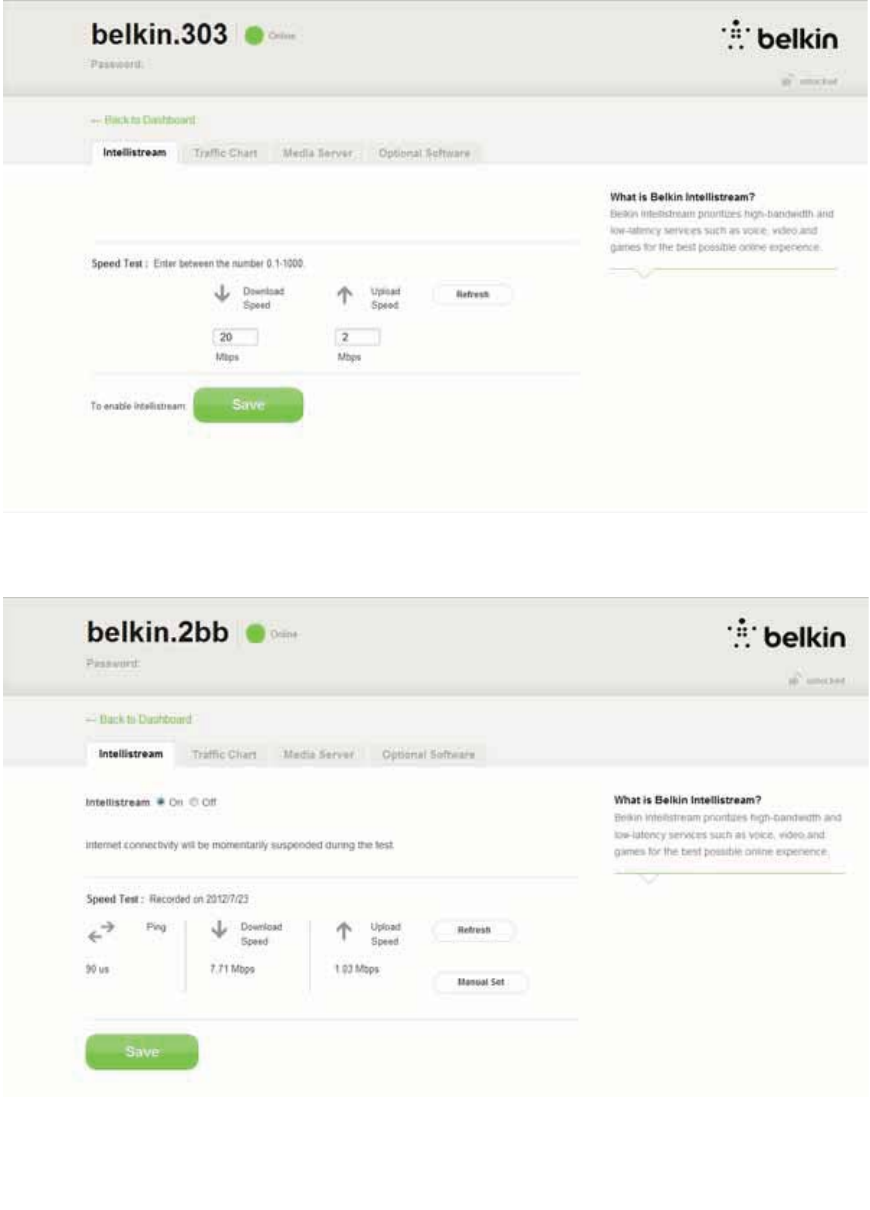
When you click “Save,” your Router will save your changes.
Intellistream is now enabled.
IPv6 Configuration
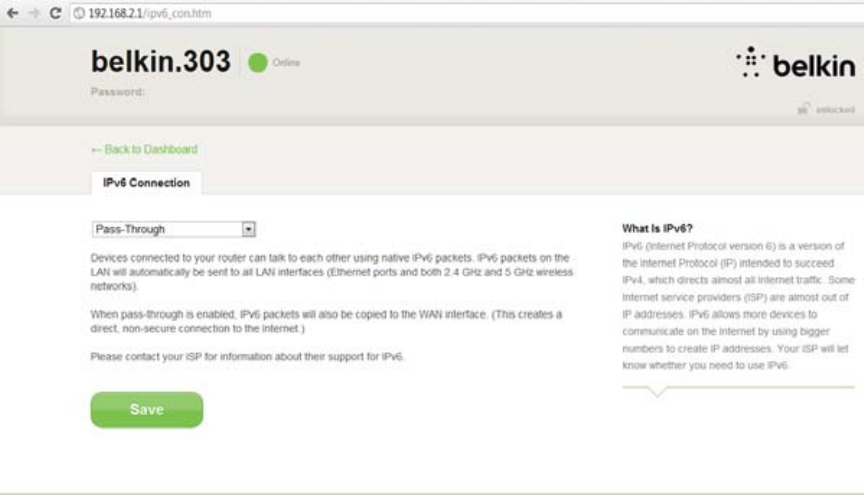
A new version of Internet Protocol (IP) uses a 128-bit address to implement
additional features that are not present in current IP addresses.
Contact your ISP to inquire about their support for IPv6.
Pass-Through
Devices connected to your Router can talk to each other using
native IPv6 packets, but information will be sent to all connected
devices. Pass-through is not efficient and is not recommended for
consistent use.
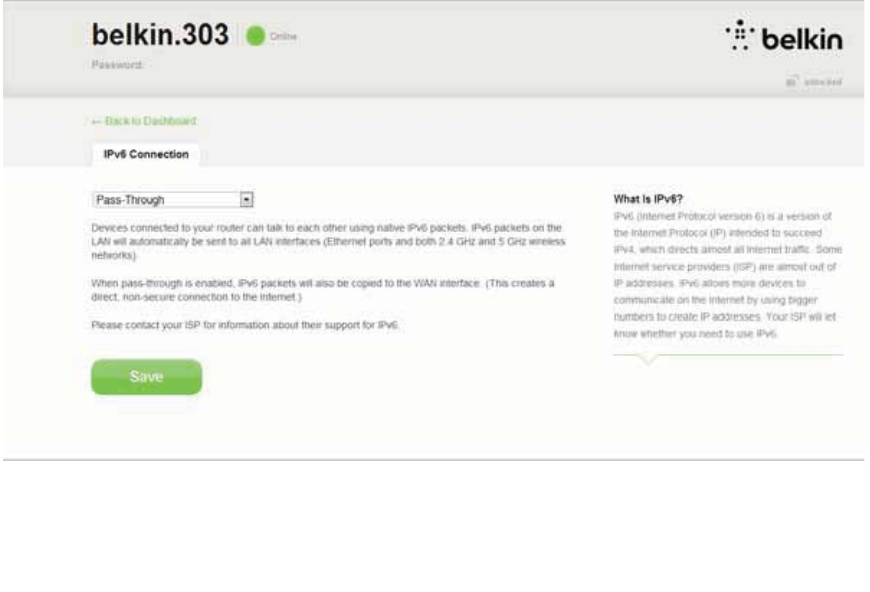
Getting to Know Your Router
Front Panel
[DIAGRAMfront.ai]
A)RouterStatusLight
YourRouter’sstatusisshownbythelightonthefront.
Off:TheRouterisnotpluggedintoapowersource.
BlinkingBlue:TheRouterisstartingup.
SolidBlue:TheRouterisconnectedtotheInternet.
BlinkingAmber:TheRoutercan’tdetectthemodem.Eitherthemodemis
off,isnotpluggedintotheRouter,orisunresponsive.
B)WiFiProtectedSetup(WPS)LightandButton
TheWPSbuttononthefrontofyourRoutercanbeusedtohelp
establishasecureconnectionbetweenyourRouterandotherWPS
enabledWiFidevicessuchascomputers.TouseWPS,referto
page9.
ThesmalllightneartheWPSbuttonshowswhatishappening
whileyouareusingWPStoestablishaconnection.
Off:Idle
BlinkingBlue:TheRouterislisteningforaWPSenabledcomputeror
otherdevice.
SolidBlue:TheRouterhasmadeasecureconnectionwiththecomputeror
otherdevice.
Amber:Aconnectionwasnotcreated.
Back Panel
[RDIAGRAMFORSHAREANDPLAYr_shareplay_back.ai]
A)Modem(WAN)Connector
ConnectyourmodemtothisportusinganEthernetcable.
B)Wired(LAN)Connectors
Connectcomputersandotherwirednetworkdevicestotheseports
usingEthernetcables.
C)USBPort
USBprinters,disks,andotherUSBdevicespluggedintothisport
willbesharedonyournetwork.EachUSBporthasalightthat
indicatesitsstatus.
Off:NoUSBdeviceisconnectedortheattachedUSBdeviceisnotinuse.
Blinking:Pleasewaittounplugthedeviceuntilthelightturnsoff.
On:TheUSBdeviceisconnectedandbeingsharedonyournetwork.
D)ResetButton
ThisbuttonisusedtorestartyourRouterinrarecaseswhenit
functionsincorrectly.ResettingtheRouterwillpreserveyour
settings.Thisbuttonmayalsobeusedtorestorethefactorydefault
settings.PleaseseetheTroubleshootingsectionformore
information.
E)PowerConnector
Connecttheincludedpowersupplytothisjack.
Technical Details
Technical Features
Integrated 802.11n Wireless Access Point
Utilizing Dual-Band Network technology, your Router creates two
separate networks (one at 2.4GHz band and the other at 5GHz band),
allowing increased bandwidth to all your connected wireless devices and
computers.
NAT IP Address Sharing
To save you the cost of adding IP addresses per computer in your house,
your Belkin Router uses Network Address Translation (NAT) technology,
allowing you to share a single IP address across your network.
SPI Firewall
Your Router is equipped with a firewall that will protect your network
from a wide array of common attacks and viruses.
Universal Plug-and-Play (UPnP) Compatibility
UPnP offers seamless operation of voice and video messaging, games, and
other applications that are UPnP-compliant.
Web-Based Advanced User Interface
You can easily make changes to your Router’s advanced settings through
your web browser. These changes can be made from any computer on your
network.
Integrated 4-Port Gigabit Switch
Your Router has a built-in, 4-port network switch to allow your wired
computers to share: printers, data, MP3 files, digital photos, and much
more.
USB Port
The USB port lets you plug in printers, hard drives, and other USB
devices to share across your network.
System Requirements
Router

Broadband Internet connection such as a cable or DSL modem with RJ45
(Ethernet) connection
At least one computer with an installed network interface adapter
TCP/IP networking protocol installed on each computer
RJ45 Ethernet networking cable
Internet browser
Setup
A computer running Internet Explorer® 8 or higher, Firefox®, Google
Chrome™, or Safari®
Minimum 1GHz processor and 512MB RAM
Or a smart device running iOS or Android operating systems
USB Print and Storage Manager
Windows XP SP3 or higher, Windows Vista, or Windows 7; or Mac OS X
v10.5 or above
Minimum 1GHz processor and 512MB RAM
50MB of free hard-drive space for installation
Using Your Router
Auto Update on Your Belkin Router
The Router will automatically check for a newer version of firmware every time you log into the
dashboard and alert you with a message at the top of the screen if there is an update
available. You can choose to download the new version or ignore it.
You will see a series of prompts warning you that the firmware is about to be updated. Please
do not disconnect the power from the Router at this time as it could cause the system to fail.
Updating the Router’s Firmware via the Web Interface
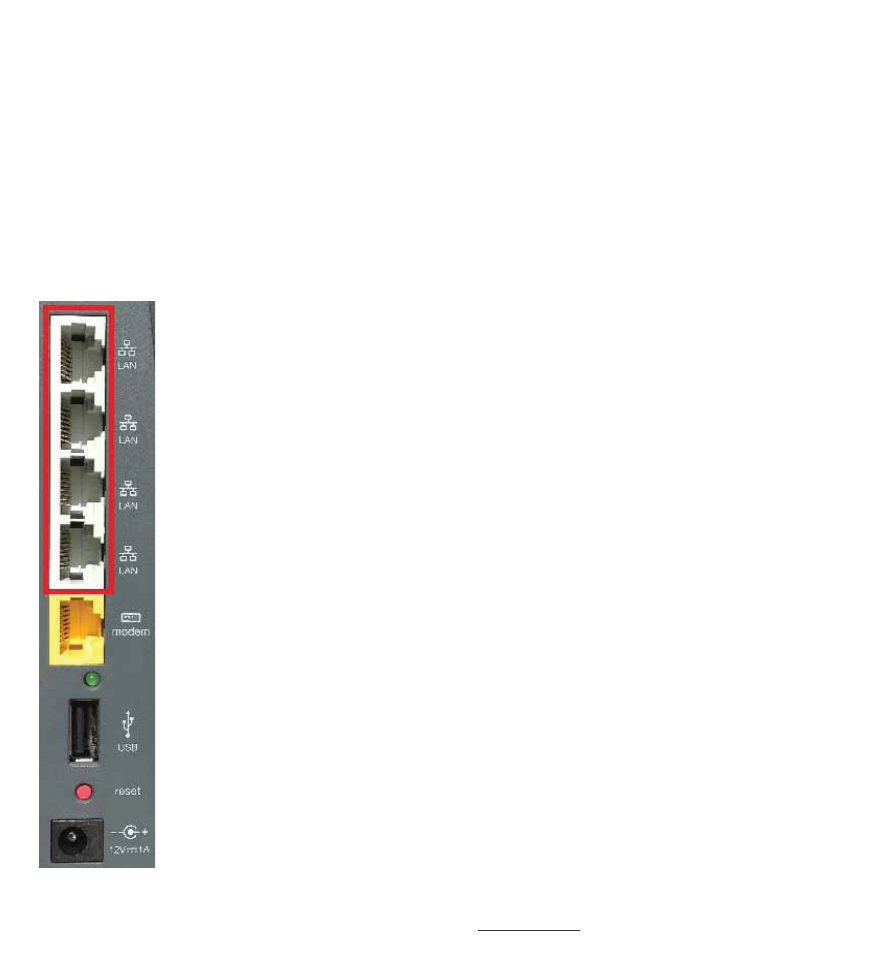
The following steps show you how to update your Router’s firmware using its web interface.
You do not need to be connected to the Internet as this interface is built into the Router
itself.
Setup steps:
1. Locate and download the firmware file from the Belkin support site. (Type your part
number into the search box in the top right corner and look for “Firmware” in the title.)
2. Save the file to a location on your computer where you can get to it easily, such as your
desktop.
3. Connect the computer to one of the four LAN ports on the Router (refer to image).
4. Open a web browser on the computer.
5. In the address bar of the web browser, type “http://router” or “http://192.168.2.1” and
press “Enter” on your keyboard.
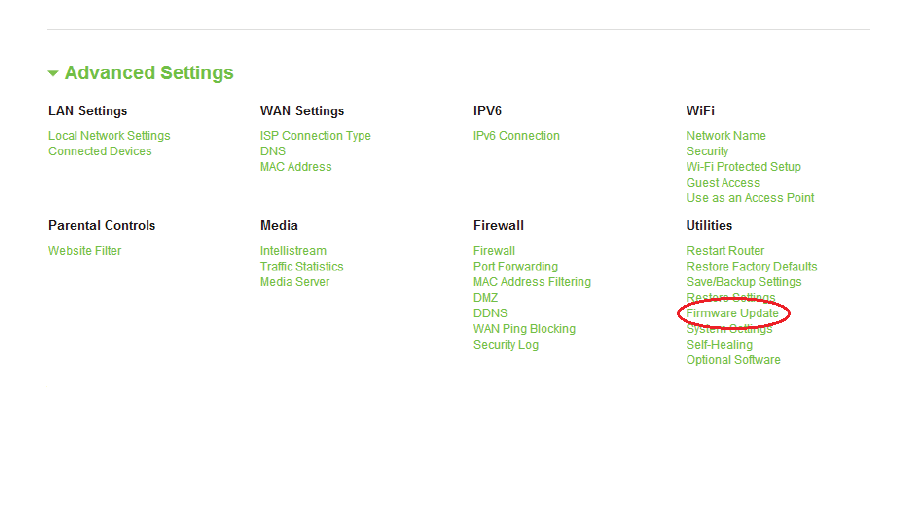
6. Click on “Firmware Update” toward the bottom.
7. Click the “Choose File” button toward the middle of the screen to search for the file you
saved previously.
Note: The firmware version in the image above is depicted as an example. Your file name will
vary depending on your model and version.
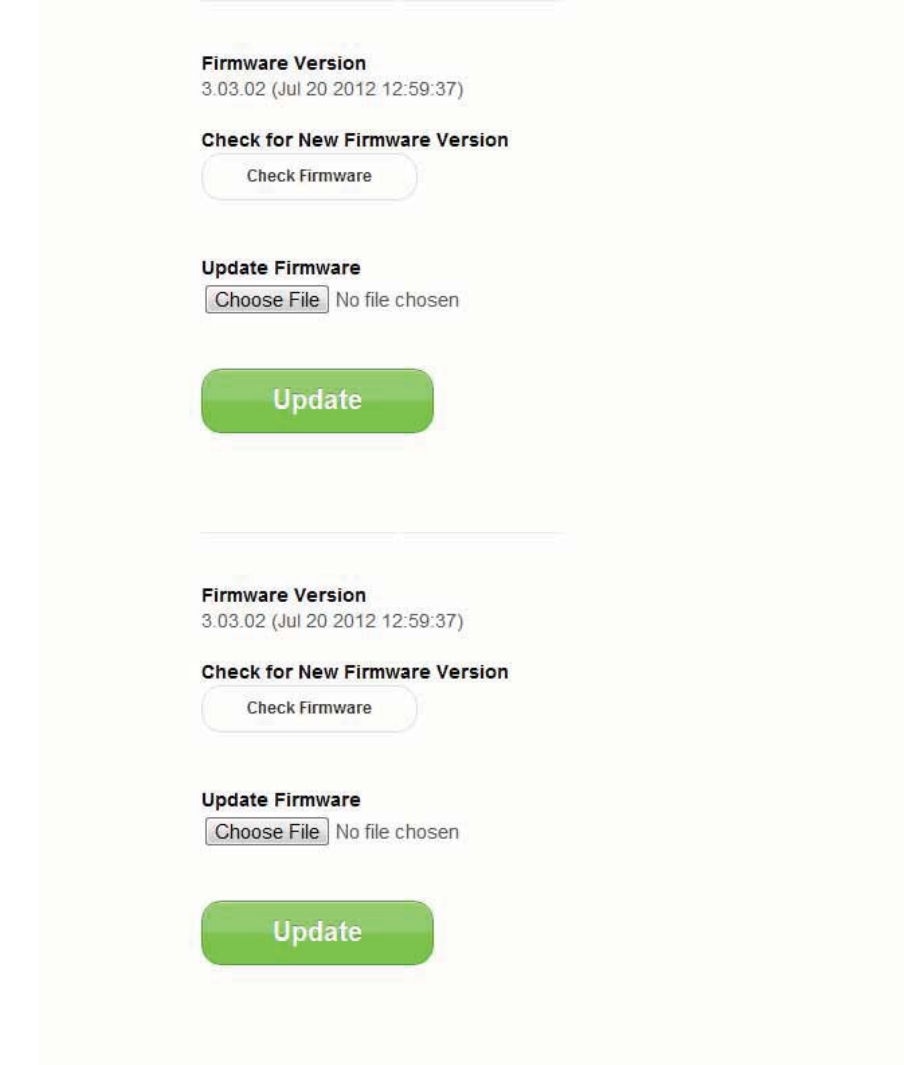
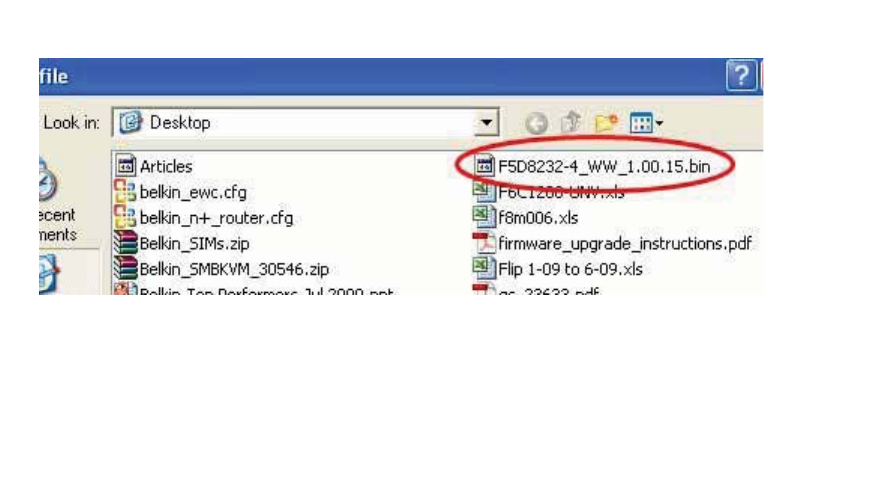
8. Select the firmware file by left-clicking on it and then click the “Open” button in the lower-
right corner of the window. This will take you back into the Router’s interface.
9. Click the “Update” button.
10. A prompt asking, “Are you sure you want to continue with upgrading?” will appear. Click
“OK”.
11. A second prompt will open telling you the Router will not respond during the upgrade and
warning you not to remove the power supply from the Router. Click “OK” once more.
Congratulations. The firmware has been updated successfully.
Resetting the Router
Reset Button – Red
The “Reset” button is used in rare cases when the Router may function improperly. Resetting the
Router will restore the Router’s normal operation while maintaining the programmed settings. You
can also restore the factory default settings by using the “Reset” button. Use the restore option in
instances where you may have forgotten your custom password.
Resetting the Router
Push and release the “Reset” button. The lights on the Router will momentarily flash. The
“Router” light will begin to blink. When the “Router” light becomes solid again, the reset is
complete.
Restoring Your Router to Factory Defaults
Press and hold the “Reset” button for at least 5 seconds, and then release it. The lights on the
Router will momentarily flash. The “Router” light will begin to blink. When the “Router” light
becomes solid again, the restore is complete.
Restoring the Router to Default Settings Using the Web Interface
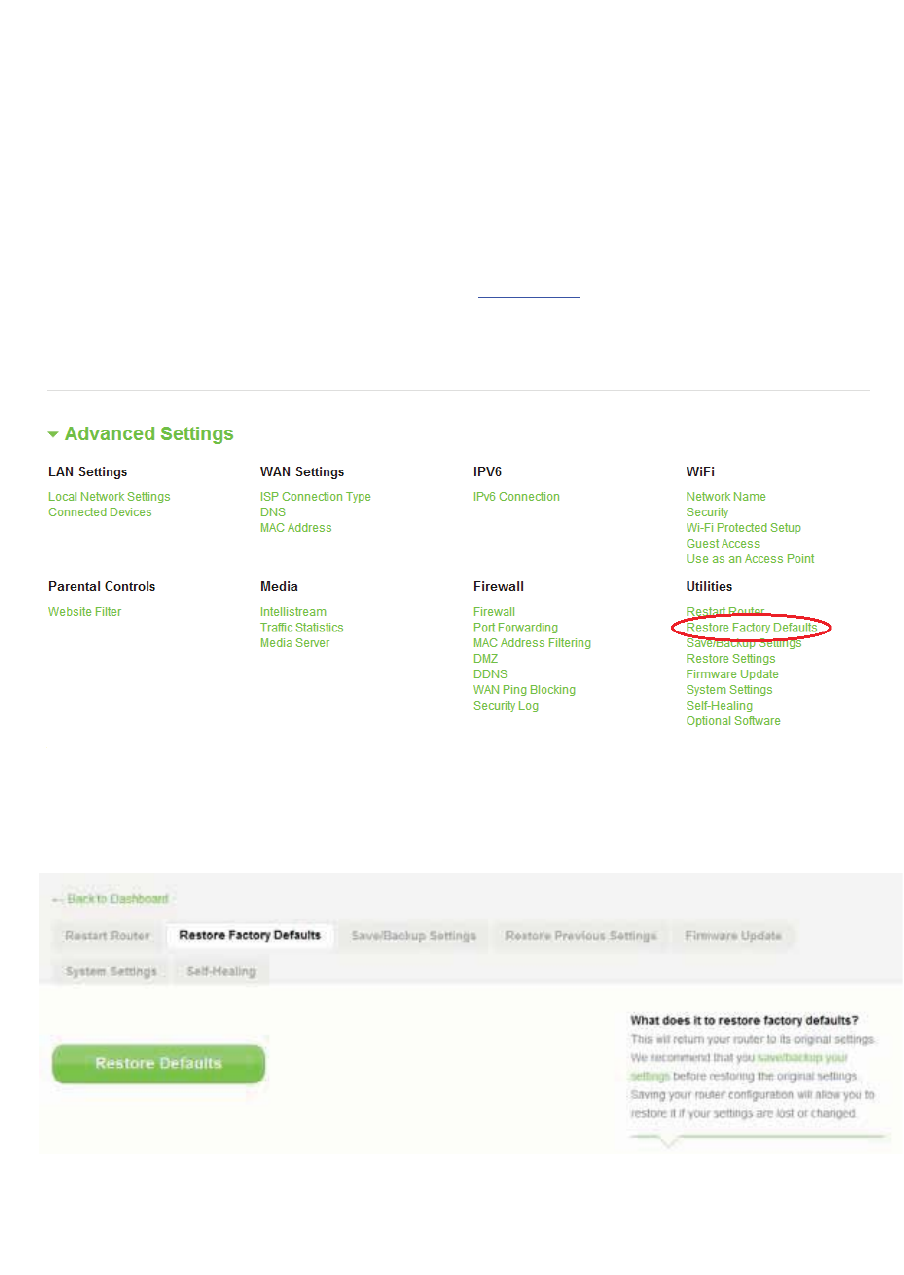
Symptoms
You need to restore the factory defaults using the web interface. This may be because the
Router is not performing as expected or you wish to remove all previously configured
settings.
Setup steps:
1. Open a web browser on the computer.
2. In the address bar of the web browser, type “http://router” or “http://192.168.2.1”.
3. Click on “Restore Factory Defaults” in the left-hand column under the “Utilities”
heading.
4. Click on the “Restore Defaults” button.
5. A warning box will open that says, “Warning: All your settings will be lost. Are you sure
you want to do this?” Click “OK”.

6. The Router will begin the restoring process. Once the restore is complete, the Router will
reboot.
Note: This may take several minutes.
Your Router has successfully been restored to its factory settings.
Troubleshooting, Support, and Warranty
Troubleshooting
Ican’tconnecttotheInternetwirelessly.
IfthelightonthefrontoftheRouterissolidblue,thenyourRouter
isconnectedtotheInternet.Youmaynotbeconnectedtothe
Router’swirelessnetwork.Pleasereferto“ConnectYourWireless
Devices”onpage20ofthismanualforinstructions.
If your Windows XP computer is running SP2, you will not be able to set up the Router
via the wireless setup process. You will need to either update to Windows XP SP3 or
complete the setup via a wired connection.

Ican’tconnecttotheInternetwirelesslyandmynetworknameisnotlistedin
AvailableNetworks.
1)VerifythatyourRouterisonandthefrontpanellightshows
solidblue.
2)IfyouarefarfromtheRouter,youmighttrymovingcloserto
seeifyoumighthavebeenoutofrange.
3)UsingacomputerattachedtotheRouterviaanetworkcable,
visithttp://router/andensurethat“BroadcastSSID”isON.
Thissettingisfoundonthe“ChannelandSSID”page.
Mywirelessnetworkperformanceisslow,inconsistent,suffersfromweak
signal,orI’mhavingdifficultymaintainingaVPNconnection.
Wireless technology is radio-based, which means connectivity
and the throughput performance between devices decreases
when the distance between devices increases. Other factors that
will cause signal degradation (metal is generally the worst
culprit) are obstructions such as walls and metal appliances.
Note also that connection speed may decrease as you move
farther away from the Router.
In order to determine if wireless issues are related to range, we
suggest temporarily moving the computer within 10 feet from
the Router if possible.
Changing the wireless channel—Depending on local wireless traffic and
interference, switching the wireless channel of your network can
improve performance and reliability. See the section titled
“Changing the Wireless Channel” for instructions on how to
choose other channels.
Limiting the wireless transmit rate—Limiting the wireless transmit rate can
help improve range and connection stability. Most wireless
cards have the ability to limit the transmission rate. To change
this property in Windows, go to the Windows Control Panel,
open “Network Connections”, and double-click on your wireless
card’s connection. In the properties dialog, select the
“Configure” button on the “General” tab, then choose the
“Advanced” tab and select the rate property.

Wireless client cards are usually set to automatically adjust the
wireless transmit rate for you, but doing so can cause periodic
disconnects when the wireless signal is too weak; as a rule,
slower transmission rates are more stable. Experiment with
different connection rates until you find the best one for your
environment. Note that all available transmission rates should
be acceptable for browsing the Internet. For more assistance,
see your wireless card’s user manual.
I’veinstalledthisnewRouterandsomeofmynetworkclients(computers,
gameconsoles,etc.)arenowunabletoconnect.
YournewRoutercamepreconfiguredwithanetworknameand
password,foundprintedonanattachedcard.Allclientsmustuse
thisnetworknameandpasswordtoconnectwirelesslytoyour
Router.Youwillneedtofindthenetworksettingsonyourclient,
selectthenetworknameprintedonthecardfromthelistof
availablenetworks,andenterthepasswordwhenpromptedtojoin
thewirelessnetwork.
DoestheRoutersupportWirelessProtectedAccess(WPA)security?
TheRoutershipswithWPA/WPA2securityturnedon.WindowsXP
andsomeoldernetworkhardwaremayrequireasoftwareupdate
tosupportWPA/WPA2.
IamhavingdifficultysettingupWPAsecurityonmyRouter.
1) LogintoyourRouterbyvisiting“http://router/dzor
“http://192.168.2.1”withyourwebbrowser.Click“Security”
undertheWiFiheading.YoushouldnowbeontheSecurity
page.
2) UnderSecurityMode,selectWPA/WPA2Personal(PSK).
3) Select“WPA/WPA2”
fromthedropdownmenuundertheAuthenticationheading
4) .Enterapassword.Thiscanbefrom8–63charactersofyour
choice,includingspacesandpunctuation,ORa64digit
hexadecimalnumber(usingonlythenumbers0–9andletters
A–F).

5) Click“Save”tofinish.Yourwirelessconnectionisnow
encrypted.Eachcomputerusingyourwirelessnetworkwill
needtousethenewkey.
Note:IfyouareconfiguringtheRouteroverawireless
connection,youwillhavetoreconnecttotheRouterafter
changinganysecuritysettings.
Note:SomeoldernetworkinghardwaresupportsonlyWEP
encryption.Ifyouroldercomputerscannotconnecttoyour
network,try128bitor64bitWEP,orseeksoftwareupdates
fromtheirmanufacturers.
IamhavingdifficultysettingupWiredEquivalentPrivacy(WEP)securityonmy
Router.
1) LogintoyourRouter.Visit“http://router/dz
“http://192.168.2.1”withyourwebbrowser.Click
“Security” under the WiFi heading. You should now be on
the Security page.
2) UnderSecurityMode,selectthe“128bitWEP”option.
3) YoumaytypeinaWEPkeymanually,orgenerateonefroma
passphrase.Typeaphraseinthe“Passphrase”fieldandclick
the“Generate”button.AWEPkeyiscomposedof26
hexadecimaldigits(0–9,A–F).Forexample,C3030FAF4B
B2C3D44BC3D4EE74isavalid128bitWEPkey.
4) Click“Save”tofinish.Yourwirelessactivityisnowencrypted.
Eachcomputerusingyourwirelessnetworkwillneedtouse
thenewkey.
Note:IfyouareconfiguringtheRouteroverawireless
connection,youwillhavetoreconnecttotheRouterafter
changinganysecuritysettings.
Note:Someoldernetworkinghardwaresupportsonly64bit
WEPencryption.Ifyouroldercomputerscannotconnectto
yournetwork,try64bitWEP.
AdiskIpluggedintotheUSBportisnotshowinguponmycomputer.
1)Tryunpluggingandrepluggingthedisk.Pleasecheckthat
theUSBconnectorisfirmlypluggedintotheRouter.
2)Ifyourdiskhasanoptionalpowersupply,pleaseuseitwhile
thediskisattachedtoyourRouter.
3)TheRoutersupportsFAT16,FAT32,orNTFSformatteddisks.
DisksinotherformatswillnotappearintheFinder(MacOS
X)orWindowsInternetExplorer®.
AdiskIpluggedintotheUSBportisnotcomingonorremainsononlyfora
shorttime.
SomedrivesrequiremorepowerthantheRouter’sUSBportprovides.If
yourdiskhasanoptionalpowersupply,pleaseuseitwhilethediskis
attachedtoyourRouter.
AprinterIpluggedintotheUSBportisnotshowinguponmycomputer.
1)Tryunpluggingandrepluggingtheprinter.Pleasecheckthat
theUSBconnectorisfirmlypluggedintotheRouter.
2)ToprinttoaprinterattachedtotheRouter,yourcomputer
musthavethatprinter’sdriverinstalled.Pleasecheckthat
thedriverisinstalled.
3)Theprintermaynotbesettoautoconnect.OpentheUSB
PrintandStorageCenter.Checkthattheprinterappearsin
thelistofavailabledevices.Viewthepropertiesoftheprinter,
andcheckthat“autoconnect”isselected.
AdifferentsortofUSBdevicethatIpluggedintotheUSBportisnotshowingup
onmycomputer.
MostUSBdevicesotherthandisksandprintersmustbe
accessedviatheUSBPrintandStorageCenter.
1)Tryunpluggingandrepluggingthedevice.Pleasecheckthat
theUSBconnectorisfirmlypluggedintotheRouter.
2)OpentheUSBPrintandStorageCenter.Checkthatthedevice
appearsinthelistofavailabledevices.

3)Selectthedeviceandclickthe“Use”button.Thedevicewill
bevirtuallyconnectedtoyourcomputeruntilyouchooseto
“StopUsing”thedevice,oranotherpersonrequestsuseofthe
device.
Technical Support
US
http://www.belkin.com/support
UK
http://www.belkin.com/uk/support
Australia
http://www.belkin.com/au/support
NewZealand
http://www.belkin.com/au/support
Singapore
1800 622 1130
Europe
http://www.belkin.com/uk/support
Belkin International, Inc., Limited 2-Year Product Warranty
What this warranty covers.
Belkin International, Inc. (“Belkin”) warrants to the original purchaser of this
Belkin product that the product shall be free of defects in design, assembly,
material, or workmanship.
What the period of coverage is.
Belkin warrants the Belkin product for two years.
What will we do to correct problems?
Product Warranty.
Belkin will repair or replace, at its option, any defective product free of charge
(except for shipping charges for the product). Belkin reserves the right to
discontinue any of its products without notice, and disclaims any limited warranty
to repair or replace any such discontinued products. In the event that Belkin is
unable to repair or replace the product (for example, because it has been
discontinued), Belkin will offer either a refund or a credit toward the purchase of
another product from Belkin.com in an amount equal to the purchase price of the
product as evidenced on the original purchase receipt as discounted by its
natural use.
What is not covered by this warranty?
All above warranties are null and void if the Belkin product is not provided to
Belkin for inspection upon Belkin’s request at the sole expense of the purchaser,
or if Belkin determines that the Belkin product has been improperly installed,
altered in any way, or tampered with. The Belkin Product Warranty does not
protect against acts of God such as flood, lightning, earthquake, war, vandalism,
theft, normal-use wear and tear, erosion, depletion, obsolescence, abuse,
damage due to low voltage disturbances (i.e. brownouts or sags), non-authorized
program, or system equipment modification or alteration.
How to get service.
To get service for your Belkin product you must take the following steps:
1. Contact Belkin International, Inc., at 12045 E. Waterfront Drive, Playa
Vista, CA 90094, Attn: Customer Service, or call (800)-223-5546, within 15 days
of the Occurrence. Be prepared to provide the following information:
a. The part number of the Belkin product.
b. Where you purchased the product.
c. When you purchased the product.
d. Copy of original receipt.
2. Your Belkin Customer Service Representative will then instruct you on
how to forward your receipt and Belkin product and how to proceed with your
claim.
Belkin reserves the right to review the damaged Belkin product. All costs of
shipping the Belkin product to Belkin for inspection shall be borne solely by the
purchaser. If Belkin determines, in its sole discretion, that it is impractical to ship
the damaged equipment to Belkin, Belkin may designate, in its sole discretion, an
equipment repair facility to inspect and estimate the cost to repair such
equipment. The cost, if any, of shipping the equipment to and from such repair
facility and of such estimate shall be borne solely by the purchaser. Damaged
equipment must remain available for inspection until the claim is finalized.
Whenever claims are settled, Belkin reserves the right to be subrogated under
any existing insurance policies the purchaser may have.
How state law relates to the warranty.
THIS WARRANTY CONTAINS THE SOLE WARRANTY OF BELKIN. THERE
ARE NO OTHER WARRANTIES, EXPRESSED OR, EXCEPT AS REQUIRED
BY LAW, IMPLIED, INCLUDING THE IMPLIED WARRANTY OR CONDITION
OF QUALITY, MERCHANTABILITY OR FITNESS FOR A PARTICULAR
PURPOSE, AND SUCH IMPLIED WARRANTIES, IF ANY, ARE LIMITED IN
DURATION TO THE TERM OF THIS WARRANTY.
Some states do not allow limitations on how long an implied warranty lasts, so
the above limitations may not apply to you.
IN NO EVENT SHALL BELKIN BE LIABLE FOR INCIDENTAL, SPECIAL,
DIRECT, INDIRECT, CONSEQUENTIAL OR MULTIPLE DAMAGES SUCH AS,
BUT NOT LIMITED TO, LOST BUSINESS OR PROFITS ARISING OUT OF THE
SALE OR USE OF ANY BELKIN PRODUCT, EVEN IF ADVISED OF THE
POSSIBILITY OF SUCH DAMAGES.
This warranty gives you specific legal rights, and you may also have
other rights, which may vary from state to state. Some states do not
allow the exclusion or limitation of incidental, consequential, or other
damages, so the above limitations may not apply to you.
*Regulatory Information
FCC Statement
DECLARATION OF CONFORMITY WITH FCC RULES FOR
ELECTROMAGNETIC COMPATIBILITY
This device complies with Part 15 of the FCC Rules. Operation is subject to the
following two conditions: (1) This device may not cause harmful interference, and
(2) this device must accept any interference received, including interference that
may cause undesired operation.
Caution: Exposure to Radio Frequency Radiation. The radiated output power of
this device is far below the FCC radio frequency exposure limits. Nevertheless,
the device shall be used in such a manner that the potential for human contact
during normal operation is minimized. When connecting an external antenna to
the device, the antenna shall be placed in such a manner to minimize the
potential for human contact during normal operation. In order to avoid the
possibility of exceeding the FCC radio frequency exposure limits, human
proximity to the antenna shall not be less than 20cm (8 inches) during normal
operation.
Federal Communications Commission Notice
This equipment has been tested and found to comply with the limits for a Class B
digital device, pursuant to Part 15 of the FCC Rules. These limits are designed to
provide reasonable protection against harmful interference in a residential
installation.
This equipment generates, uses, and can radiate radio frequency energy, and if
not installed and used in accordance with the instructions, may cause harmful
interference to radio communications. However, there is no guarantee that
interference will not occur in a particular installation. If this equipment does cause
harmful interference to radio or television reception, which can be determined by
turning the equipment off and on, the user is encouraged to try and correct the
interference by one or more of the following measures:
x Reorient or relocate the receiving antenna.
x Increase the distance between the equipment and the receiver.
x Connect the equipment to an outlet on a circuit different from that to which the
receiver is connected.
x Consult the dealer or an experienced radio/TV technician for help.
FCC Caution: Any changes or modifications not expressly approved by the party
responsible for compliance could void the user’s authority to operate this
equipment.
This device and it's antennas(s) must not be co-located or operating in
conjunction with any other antenna or transmitter except in accordance with FCC
multi-transmitter product procedures.
This device is going to be operated in 5.15~5.25GHz frequency range, it is
restricted for indoor environment only.
For product available in the USA/Canada market, only channel 1~11 can be
operated. Selection of other channels is not possible.
Modifications
The FCC requires the user to be notified that any changes or modifications to this
device that are not expressly approved by Belkin International, Inc., may void the
user’s authority to operate the equipment.
Industry Canada Statement
Operations in the 5.15-5.25GHz band are restricted to indoor usage only.
IMPORTANT NOTICE:
FCC Radiation Exposure Statement:
This equipment complies with FCC radiation exposure limits set forth for an
uncontrolled environment. This equipment should be installed and operated with
a minimum distance of 20cm between the radiator and your body.
Industry Canada Statement:
This device complies with Industry Canada license-exempt RSS standard(s).
Operation is subject to the following two conditions: (1) This device may not
cause harmful interference, and (2) this device must accept any interference
received, including interference that may cause undesired operation.
Le présent appareil est conforme aux CNR d'Industrie Canada applicables aux
appareils radio exempts de licence. L'exploitation est autorisée aux deux
conditions suivantes : (1) l'appareil ne doit pas produire de brouillage, et (2)
l'utilisateur de l'appareil doit accepter tout brouillage radioélectrique subi, même
si le brouillage est susceptible d'en compromettre le fonctionnement.
IMPORTANT NOTE:
Radiation Exposure Statement:
This equipment complies with IC radiation exposure limits set forth for an
uncontrolled environment. This equipment should be installed and operated with
a minimum distance of 20cm between the radiator and your body.
Déclaration d'exposition aux radiations:
Cet équipement est conforme aux limites d'exposition aux rayonnements IC
établies pour un environnement non contrôlé. Cet équipement doit être installé et
utilisé avec un minimum de 20cm de distance entre la source de rayonnement et
votre corps.
Caution
(i) the device for operation in the band 5150-5250 MHz is only for indoor use to
reduce the potential for harmful interference to co-channel mobile satellite
systems.
Avertissement:
les dispositifs fonctionnant dans la bande 5150-5250 MHz sont réservés
uniquement pour une utilisation à l’intérieur afin de réduire les risques de
brouillage préjudiciable aux systèmes de satellites mobiles utilisant les mêmes
canaux.
This radio transmitter (IC: 3623A-F9K1117V2/ Model:F9K1113V4) has been
approved by Industry Canada to operate with the antenna types listed below with
the maximum permissible gain and required antenna impedance for each
antenna type indicated. Antenna types not included in this list, having a gain
greater than the maximum gain indicated for that type, are strictly prohibited for
use with this device.
Ce dispositif a été conçu pour fonctionner avec une antenne ayant un gain
maximal de PCB dipole antenne avec dB [4.11]. Une antenne à gain plus élevé
est strictement interdite par les règlements d'Industrie Canada. L'impédance
d'antenne requise est de 50 ohms.
Under Industry Canada regulations, this radio transmitter may only operate using
an antenna of a type and maximum (or lesser) gain approved for the transmitter
by Industry Canada. To reduce potential radio interference to other users, the
antenna type and its gain should be so chosen that the equivalent isotropically
radiated power (e.i.r.p.) is not more than that necessary for successful
communication.
Conformément à la réglementation d'Industrie Canada, le présent émetteur radio
peutfonctionner avec une antenne d'un type et d'un gain maximal (ou inférieur)
approuvé pourl'émetteur par Industrie Canada. Dans le but de réduire les risques
de brouillage radioélectriqueà l'intention des autres utilisateurs, il faut choisir le
type d'antenne et son gain de sorte que lapuissance isotrope rayonnée
équivalente (p.i.r.e.) ne dépasse pas l'intensité nécessaire àl'établissement d'une
communication satisfaisante.
Le présent émetteur radio (IC: 3623A-F9K1117V2/ Model: F9K1113V4) a été
approuvé par Industrie Canada pour fonctionner avec les types d'antenne
énumérés ci-dessous et ayant un gain admissible maximal et l'impédance
requise pour chaque type d'antenne. Les types d'antenne non inclus dans cette
liste, ou dont le gain est supérieur au gain maximal indiqué, sont strictement
interdits pour l'exploitation de l'émetteur.
For product available in the USA/Canada market, only channel 1~11 can be
operated. Selection of other channels is not possible.
Pour les produits disponibles aux États-Unis / Canada du marché, seul le canal 1
à 11 peuvent être exploités. Sélection d'autres canaux n'est pas possible.
This device and it's antennas(s) must not be co-located or operating in
conjunction with any other antenna or transmitter except in accordance with IC
multi-transmitter product procedures.
Cet appareil et son antenne (s) ne doit pas être co-localisés ou fonctionnement
en association avec une autre antenne ou transmetteur.
*Back cover
<NEW BELKIN FONTS>
© 2012 Belkin International, Inc. All rights reserved. All trade names are
registered trademarks of respective manufacturers listed. iPad, iPhone, iPod
touch, Mac, Mac OS, and Safari are trademarks of Apple Inc., registered in the
U.S. and other countries. Windows, Windows Vista, Internet Explorer, and
DirectX are either registered trademarks or trademarks of Microsoft Corporation
in the United States and/or other countries. Android and Google Chrome are
trademarks of Google Inc.